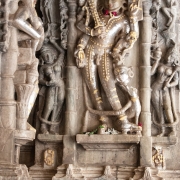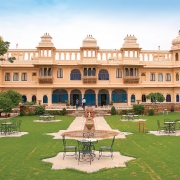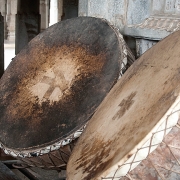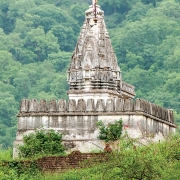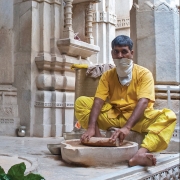
Etcetera
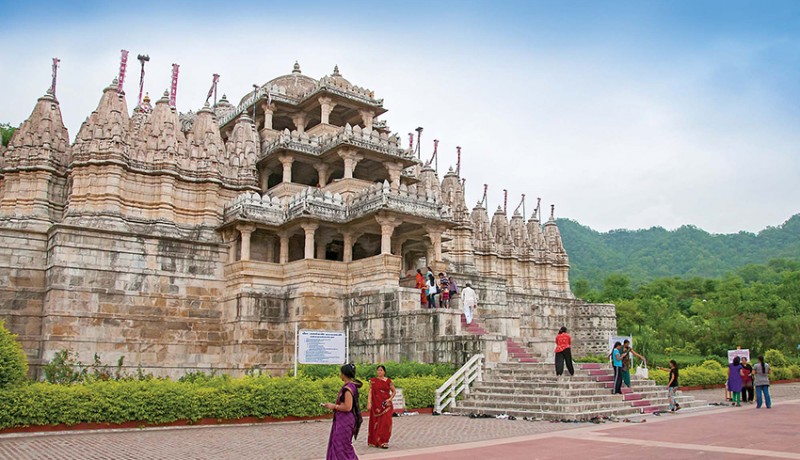
With endless carved pillars, ornate domes and complex design, the Jain temple of Ranakpur is a celestial dream in stone
We sped past two Jain nuns in white robes, carrying all their worldly possessions with them. They trudged barefoot down the highway that twisted across the ruddy landscape of Rajasthan. We were heading to the same destination: the mysterious and beautiful Jain temple town of Ranakpur. We were driven by curiosity; they let stoic devotion lead the way.
Tucked away in the folds of the forested Aravalli hills, the ancient 15th century temple of Ranakpur, 90 km from Udaipur, has something for everyone. It took us a while, and the promptings of our pujari-guide, to unravel the layout of the temple complex that stands on a massive plinth measuring 48,000 sq ft.
The moment we stepped inside this architectural marvel, we were awed by the complexity of its design: endless carved pillars, ornate domes and small shrines that encircled the main one that houses the four-sided figure of Lord Adinath, the first of the 24 tirthankara (teaching god). We were surrounded by a profusion of delicate carved sculptures depicting various deities, saints, celestial beings and playful nymphs.
Slowly, the complex scheme started to unravel into a symmetric whole, as the pujari-guide revealed that the temple has 29 halls, 20 domes and 1,444 pillars, all covered with lavish and delicate carvings. Astoundingly, no two pillars are alike. So also the overhead domes adorned with lavish images around ornate central pendants. The entire complex has been planned in such a way that natural light pours in through open courtyards. And no, it was not the light playing tricks but one pillar was distinctly crooked. According to the resident-pujari, it was intentionally built that way; a flaw to establish the fact that perfection is the prerogative of the Gods.
Ranakpur, we felt, was different from most Indian temple towns in that we did not feel a sense of compelling claustrophobia. There was no urgency to pay our respects to the main deities and move on. We could sit in one corner and meditate in the soothing caress of its spiritual embrace or spend hours admiring this divine creation of embroidered marble.
Captured in stone are delicate etchings that depict scenes from the scriptures. The most striking is a frieze of mesmerising patterns that portray the story of prince Parshava. According to legend, the prince came upon an ascetic performing a fire sacrifice and realised that a snake lay trapped in one of the logs of fire. Overcome by pity, he grabbed an axe and split open the log and set the snake free. Naturally, this offended the ascetic who, because of his penance, was reborn a celestial being. One day while riding across the sky, he saw prince Parshava performing penance and decided to rain on his parade and drown him. Meanwhile, the snake that had been saved from the ascetic’s fire was reborn as the lord of the Nagas. He saw Parshava was in danger and spread his thousand-headed hood protectively over the prince’s head, coiled himself under his saviour and lifted him above the rising water line.
Another small panel depicts Dharnasah, the person who commissioned the temple, and Depa, the sculptor who designed it. Dharnasah was a wealthy Jain and prominent minister in the court of Rana Kumbha, the ruler of Mewar. One night in 1394, Dharnasah had a dream about the celestial vehicle used by heavenly beings and awoke the next day determined to rebuild it on earth in the form of a temple. The king was more than happy to help Dharnasah realise his dream and granted him a site along the banks of river Maghai. His sole condition was that a small township be established around the temple and named after him. Finding the man who could translate his dream into stone proved to be a long and frustrating exercise for Dharnasah. Then, one day, Depa, an eccentric recluse, knocked on his door and presented him with an architectural drawing that could well have been conceived in the heavens. Sculptures and craftsmen laboured for almost 50 years before the temple was consecrated in 1439 and dedicated to Lord Adinath.
However, around the 17th century, sensing the gathering of war clouds, the pujaris of the temple played safe and concealed the main statues in cellars under the temple and fled. Invading vandals desecrated the temple and reduced Ranakpur to ruins. Over time, it became the refuge of dacoits and criminals. Then, in the early part of the 20th century, pilgrims rediscovered the temple and were probably amazed that something of such exquisite beauty was lost to the world for so long. With loving care they started to restore it to its pristine glory.
Sharing the temple complex are smaller shrines built in a more conventional style. They might have been impressive if they had been standalone shrines at another location. Sadly, they pale in the shadow of the main structure. We did, however, stop to pay our respects to the gods enshrined in them, and then moved on to check into Fateh Bagh hotel.
Fateh Bagh has its own fascinating tale to tell. Earlier, this boutique palace hotel of the HRH Group had another avatar, another name and even another location. It was a royal palace known as Rawla Koshilav and located some 50 km from where it now stands. Time and neglect reduced the heritage property to ruins. Then, in 2002, an engineering miracle took place when the crumbling palace was dismantled brick by brick and re-assembled at its present location and enhanced with trimmings that reflected its regal heritage.
As dusk embraced the surrounding Aravalli Hills, we were back at the temple complex to partake in the evening aarti. Diyas flickered on the stairs leading into the shrine and the central sanctum. A lone nun sat in front of the main deity lost in meditation, oblivious of her surroundings. We were tempted to capture her moment in pixels but then dropped our cameras to half-mast. It would have been a shame to intrude, as we were restless tourists constantly on the move. She, however, seemed to have arrived at her spiritual destination.
FACTFILE
GETTING THERE
By air and rail: The closest airport and railway station are at Udaipur, 90 km away.
By road: State transport and private buses ply between Udaipur and Ranakpur, but services are irregular. The ideal way to get around is by car or private taxi.
ACCOMMODATION
In addition to Fateh Bagh (www.hrhhotels.com), there is Maharani Bagh Orchard, a WelcomHeritage hotel (www.welcomheritagehotels.com) located in the hunting lodge of the former rulers of Jodhpur and Rajasthan Tourism’s Hotel Shilpi Tourist Bungalow (www.rajasthantourism.gov.in).
TIPS
Foreigners are allowed inside the temple only after 12.30 pm and may not enter a cordoned-off area in front of the main shrine. Photography is allowed within the temple only after 12.30 pm.
Text & Photographs by Gustasp and Jeroo Irani Featured in Harmony — Celebrate Age Magazine October 2016
you may also like to read
-
Cracking the longevity code
Small yet impactful choices can be game-changers, writes Srirekha Pillai At 102, there’s no stopping Chandigarh-based Man Kaur, the world’s….
-
Home, not alone
While a regulatory framework is vital for senior-care facilities, the need of the hour is to develop an ecosystem to….
-
Birthday Girl
Published in a special edition to honour Japanese master storyteller Haruki Murakami’s 70th birthday, Birthday Girl (Penguin; Rs 100; 42….
-
A huge treat for music lovers
Published as the revised and updated second edition, Incomparable Sachin Dev Burman (Blue Pencil; Rs. 599; 470 pages) the authoritative….



